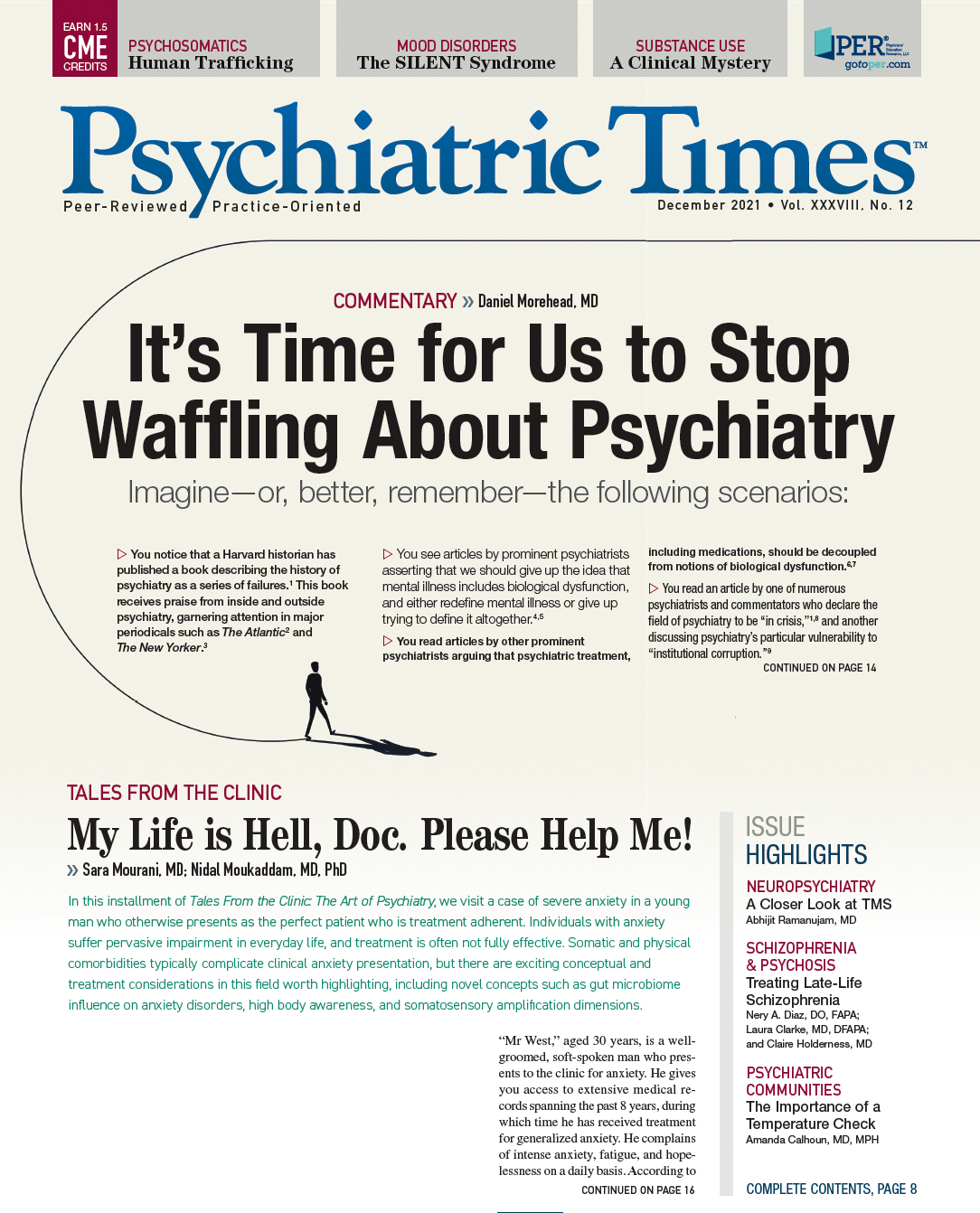Publication
Article
Psychiatric Times
Conference Presents Clinical Reviews and Updates
Author(s):
Psychiatric Times, your go-to source for what is relevant and important in the field, is pleased to share the following highlights from the 2021 Neuroscience Education Institute Congress.
xyz+/AdobeStock

CONFERENCE REPORTER
Psychiatric TimesTM attended the 2021 Neuroscience Education Institute Congress in November, which welcomed both live and virtual attendees to their 4-day conference. Psychopharmacology across the lifespan, cultural competency, and clinical challenges were among the topics discussed in live and poster sessions. Psychiatric TimesTM, your go-to source for what is relevant and important in the field, is pleased to share the following highlights.
Benzodiazepines: Opiates That Evoke a Visceral Reaction
Leah Kuntz
“Benzodiazepines. Is there any class of medications probably other than opiates that evokes that same visceral reaction? I don’t think so,” said Jeffrey R. Strawn, MD.
Strawn playfully asked the audience, “How many of you are like me—you have that love-hate relationship with the benzodiazepines?” About 90% of the in-person audience raised their hands.
To begin, Strawn discussed the advantages and disadvantages of benzodiazepine use. Advantages include rapid onset, reasonable tolerability, usefulness for breakthrough symptoms, and possible usefulness for acute and chronic anxiety. Disadvantages include initial sedation, memory impairment, falls, possible increased risk of fracture, and possible abuse dependence and withdrawal.
According to Strawn, recent findings show that approximately 7.4% of patients seen in psychiatric care are receiving benzodiazepines.1 Unfortunately, the agents are misused by 5.2 million adults, of whom 0.5 million have benzodiazepine use disorder and 0.3 million have benzodiazepine dependence.2 Factors that increase risk of misuse, use disorders, and harms include younger age, male gender, socioeconomic disadvantage, and current or history of substance use disorders, as well as being divorced, separated, or never married.
Despite these issues, Strawn said, “Benzodiazepines have a role in treating anxiety disorders, but they require monitoring and consideration of risks/benefits.”
Tolerance data are mixed, although benzodiazepines should be used carefully in patients who have a history of substance use. The agents could be beneficial when a patient has breakthrough symptoms, rapid onset is needed (eg, for panic attacks), or a patient is experiencing acute expected anxiety (eg, phobias). However, older patients and children, as well as those who concurrently use opioids, have a history of substance use disorder, are at risk of falling, or operate heavy machinery, should be carefully monitored because they the risk-benefit ratio is not as strong.
References
1. Agarwal SD, Landon BE. Patterns in outpatient benzodiazepine prescribing in the United States. JAMA Netw Open. 2019;2(1):e187399.
2. Blanco C, Han B, Jones CM, et al. Prevalence and correlates of benzodiazepine use, misuse, and use disorders among adults in the United States. J Clin Psychiatry. 2018;79(6):18m12174. ❒
Managing the 4 Most Common Adverse Effects of Antipsychotics
Erin O’Brien
Andrew J. Cutler, MD, presented on the clinical management of the 4 most common adverse effects associated with antipsychotic medications that can negatively affect treatment adherence. In “Safety First: A Comparison of the Safety and Tolerability of Antipsychotics,” Cutler discussed these adverse effect —metabolic problems, movement disorders, sedation, and sexual dysfunction1—as well as the treatment strategies medical providers can use to optimize the management of these adverse effects according to individual patient needs.
To manage metabolic problems, Cutler, who is clinical associate professor in the Department of Psychiatry at SUNY Upstate Medical University in Syracuse, New York, recommended monitoring metabolic parameters, weight gain, and appetite changes; encouraging a healthy diet and active lifestyle; choosing agents with lower incidence of weight gain when possible (eg, aripiprazole, lurasidone); considering the incorporation of metformin when initiating treatment with olanzapine or clozapine; or using olanzapine with samidorphan instead of olanzapine alone.
For movement disorders, he suggested some specific strategies for drug-induced Parkinsonism and akathisia, which both may be mitigated by reducing dosage or switching to medications with lower risk (eg, clozapine, iloperidone, lumateperone) when possible. Introducing adjunctive medications (eg, beta-adrenergic blockers, benzodiazepines) may also be helpful in cases of akathisia.
To address issues associated with sedation, Cutler recommended a few strategies, including consolidating antipsychotic medication doses into once-daily doses; identifying any potential interactions between the antipsychotics and other medications the patient may be taking; ruling out comorbid disorders that may be contributing to the sedation; and switching to antipsychotics with a lower risk of sedation (eg, lumateperone, pimavanserin) when possible.
Finally, when considering issues in sexual dysfunction, he suggested selecting an antipsychotic agent with lower likelihood of elevating prolactin (eg, lurasidone, quetiapine) or lowering prolactin (eg, brexpiprazole, cariprazine); considering adding low doses of aripiprazole to another antipsychotic that is causing sexual dysfunction and hyperprolactinemia; and incorporating psychosocial strategies such as relationship counseling and psychoeducation.1
“Medications used to treat psychosis may be the single most powerful tool in a clinician’s armamentarium for reducing antipsychotic-induced AEs,” said Cutler in his presentation. Cutler is also the chief medical officer for NEI.
Reference
1. Cutler AJ. Safety first: a comparison of the safety and tolerability of antipsychotics. Presented at: 2021 Neuroscience Education Institute Congress; November 5, 2021; Colorado Springs, CO. ❒
Improving Patient Outcomes With Cultural Humility
Erin O’Brien
Napoleon B. Higgins Jr, MD, and Rona J. Hu, MD, presented on the impact of cultural differences and issues on health disparities and unequal access to care.
Higgins and Hu reported that countless incidents of racism and oppression have occurred over the years in mental health care. For instance, patients from minority communities have often been excluded from research studies; diagnostic assessments have not been sensitive for minority populations; diagnostic and treatment algorithms often pay little attention to diversity; and not as much is known about the differences in the ways individuals from different cultures may express symptoms of mental illness. Therefore, they concluded, patients from minority communities may distrust the medical system. This lack of information about—and trust from—these communities is problematic in part because racial and ethnic minority community members will increase by 90% by 2050, the United States Census Bureau predicts.
To improve outcomes with patients from minority communities, Higgins and Hu suggested that practitioners recognize their privilege and the historical role of privilege in oppressive systems. This includes examining their own biases and stereotypes, and the ways these impact reactions to microaggressions and other cultural issues in therapeutic settings.
When you show that you’re inquisitive, it shows interest, not ignorance. When you ask the question, it shows that you’re interested in that person’s story.
They also advocated practicing cultural humility, which Higgins and Hu defined as a willingness and lifelong dedication to learn from patients about their experiences by asking questions, rather than making assumptions. “We don’t want to make assumptions—we always want to ask and be inquisitive,” Higgins said during the presentation. “When you show that you’re inquisitive, it shows interest, not ignorance. When you ask the question, it shows that you’re interested in that person’s story.”
Higgins is president and CEO of Bay Pointe Behavioral Health Service and South East Houston Research Group; executive director of Black Psychiatrists of America. Hu is a clinical professor in the Stanford Medical Center Department of Psychiatry and Behavioral Sciences. ❒
Looking for Comorbidities With ADHD From Day 1
Leah Kuntz
“It’s important that from day 1 we see the patient, we are looking for comorbidities,” said Napoleon B. Higgins Jr, MD, president and CEO of Bay Pointe Behavioral Health Services and South East Houston Research Group, medical director at Hold My Hand Residential Treatment Center, and executive director of Black Psychiatrists of America.
Higgins recommends considering the common comorbidities in the context of attention-deficit/hyperactivity disorder (ADHD) when planning treatment, and integrating treatment strategies that address both ADHD and comorbid conditions.
More than 50% of individuals with ADHD have comorbid disorders that may include learning and language disabilities, mood disorders (eg, depression, mania), anxiety, anger and impulse control disorders, and tic disorders.
Child nutrition, Higgins stressed, is key: “When you have a child’s brain being developed on poor nutrition, you are going to have poor outcomes. You cannot have a Cheeto-derived brain.”
“Whatever helps the heart, helps the mind,” Higgins said of dietary behavioral interventions, parallel training, and making sure expectations are clear.
He also advocates for focusing on “the trump cards”—comorbid conditions that must be controlled before addressing ADHD, including mania, psychosis, depression, and learning disabilities.
Bipolar disorder and ADHD may be difficult to differentiate, Higgins noted. “I will say that the most common diagnosis that an adult with bipolar disorder will have if they were seen as a child is ADHD. Why is that?” he posed. “Mood issues tend to show up in later adolescence.”
He added, when transitioning to adulthood, children with ADHD must:
1. Take ownership of their treatment and direct the interview
2. Assist in finding a mental health provider
3. Transition from a child to an adult psychiatrist
4. Be screened for substance abuse
5. Schedule follow-ups during breaks in college
6. Focus outside of educational settings
Higgins said ADHD coaching can include: finding ways for the patient to decrease distractions; setting daily goals in manageable components; prioritize tasks with time-management strategies; and use a planning system, with a set place to work or study. Understanding their own emotions is also important, as is self-motivation or self-monitoring and, potentially, prayer and meditation. ❒
Beyond Culturally Competent Care for Transgender and Gender-Diverse People
Leah Kuntz
“I am not here to speak on behalf of the trans community. I do not presume to know their lived experience. What I do strive to do, however, is to infuse the lived experiences that they have entrusted with me into everything that I do, as a clinician, as a teacher, and as a researcher,” shared, Rhonda Schwindt, DNP, RN, PMHNP-BC.
“Trans people have the right to determine who they are, and they have the right to expect that you will believe them. Now, in order to do that, we have to be willing to challenge that social construct that tells us gender can only exist within the binary male/female,” Schwindt, an associate professor and director of the Psychiatric-Mental Health Nurse Practitioner Program at George Washington University School of Nursing in Ashburn, Virginia, told conference attendees.
To ilustrate these issues, Schwindt discussed the case example of “Michael,” a 25-year-old who identifies as a transgender male. About 6 months prior to seeking assistance, Michael finally received a well-deserved and much-desired promotion; however, with the new role came a new office in a new building with new coworkers.
Almost immediately after assuming the position, Michael became the target of daily harassment, bullying, and discrimination. To avoid these interactions, Michael mapped out the nearest public restrooms, places where his coworkers could not judge him; shortly thereafter, he realized those bathroom trips were not sustainable so he began limiting his fluid intake. As a result, he required medical intervention for severe dehydration and constipation.
You can’t medicate away discrimination.
“What Michael needed was for me to be an affirming mental health care provider and to ask him about his lived experience,” Schwindt said. “When I finally did that, then we were able to bring in a team of people and work with Michael. You can’t medicate away discrimination.”
Schwindt also brought up the discouraging suicide rate in the trans community: about 40% attempt suicide. She emphasized the importance of assessing for specific gender-identity conversion efforts, which may contribute to a trans patient’s suicidal ideation.
Overall, Schwindt reminded the conference attendees, “affirmative mental health care requires a holistic, client-centered approach,” especially in the case of transgender and gender- diverse patients. ❒







